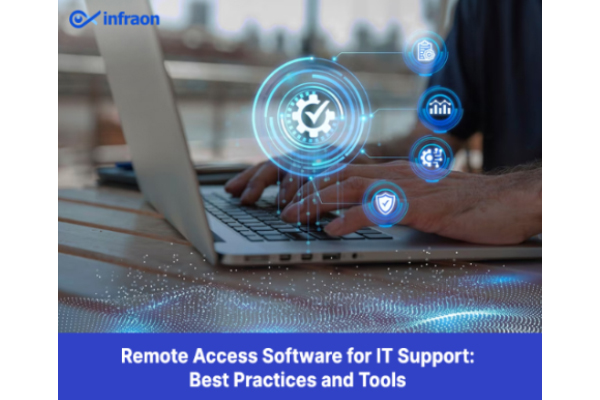Remote access software for IT support enables IT professionals to connect with and control computers or devices remotely via the web connection for troubleshooting, maintenance and technical support purposes. Typically, this system works on a client-server model. A communication protocol known as Remote Desktop Protocol (RDP), is required to establish a secure connection between the client and server. Here all the computing processes and data saving takes place on the server machine and its changes are displayed on the client’s device user-interface side. The server is responsible for processing the commands sent by the client and performing the operations on the local devices in real time.
Remote access tools are now becoming a crucial part of various departments across the organization’s ecosystem. It is beneficial for technicians as they can easily cut the long hours to resolve issues. The technicians can sit at a place far from the location, connect to the systems remotely and troubleshoot the problem without wasting time.
Now, let’s discuss the best practices for remote access software in detail.
Best Practices For Remote Access Software
Here are some best practices to make remote access as secure as possible:-
-
Enable Encryption
Encryption is the system designed to ensure the confidentiality and privacy of the data on your devices. It mitigates the risks produced by the lost or stolen device. So, if any culprit or thief were to gain any physical access to any of the remote employee’s devices, the data on it would be still protected from unauthorized access.
-
Install Antivirus and Anti-Malware
Antivirus and anti-malware software are required not only for security but also for regulatory compliance. Antivirus and anti-malware solutions provide a layer of protection, where it is most needed. Especially, it is a need for those users who when in a rush or too busy tend to do stupid things that the IT team advises against. Make sure to select the right antivirus that meets your business needs and they are installed on the devices.
-
Enforce a strong password policy
The use of weak passwords is a direct invitation to cyber attacks. Thus, to safeguard your user account from cyber attacks, one needs to enforce a strong password policy. You need to make sure that your password policy checks for length and complexity as well as disable automatic login and enable the automatic lock.
-
Use mobile devices management
While securing remote access, one of the key challenges is the difficulty of ensuring that the devices get the same level of security when they are remote as they would when in the office. This is where the Mobile Device Management (MDM) solutions help allows you to manage and monitor the devices wherever they are located. With this, you can easily install and configure the applications, push updates and manage mobile devices such as laptops, tablets, mobile phones, etc easily. It simplifies and enhances the security of portable devices, mitigating many of the risks associated with remote access.
-
Use Two Factor Authentication
It provides excellent security and is very easy to implement and comes at no extra cost. Two-factor authentication is a type of multi-factor authentication, in which your username/password pair needs to be supplemented with another method such as OTP (One-time password) to verify your identity. This additional step required for logging in to your accounts adds an additional layer of security, making it difficult for hackers to gain access to your accounts.
Why choose Infraon for remote access software?
Now that we know what are the best practices for remote access software, let’s dive into why Infraon is the best remote access software. It not only provides the checkpoints that are mentioned above but it goes well beyond. Its unique features that set it apart from others are as follows:-
- Provides authorization, authentication and adding capabilities for user access.
- Provides a secure remote access network using protocols such as CLI, RDP, and VNC.
- It includes features for secure file transfer and CLI automation.
- This cuts down the cost of a VPN, which makes this a more cost-efficient option.
Conclusion
In the above blog post, we have listed down some best practices that help to create a more secure remote working environment, without compromising on flexibility and scalability. However, you must ensure that the security systems keep pace with the changes in the threat landscape as well as in internal processes.




